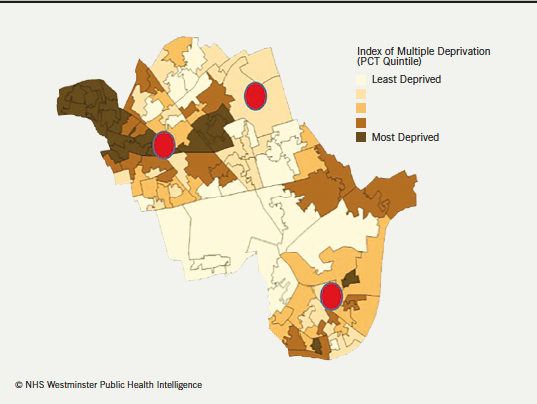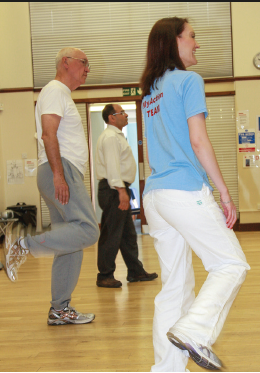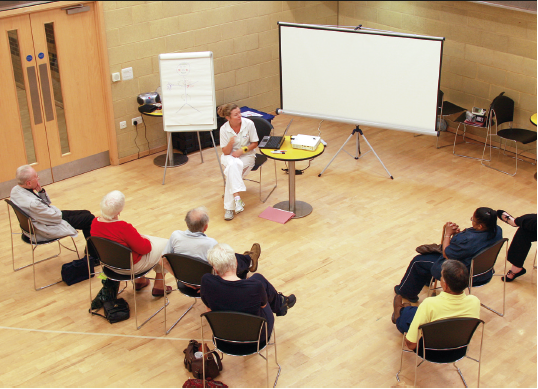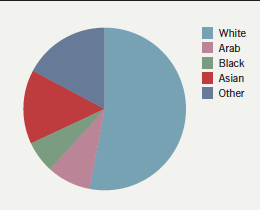MyAction Westminster: background
In response to the Department of Health (DoH) policy document Putting Prevention First,1 NHS Westminster launched its Health Checks programme in primary care in 2009. The MyAction Westminster programme was concomitantly commissioned by NHS Westminster so that those individuals identified to be at high cardiovascular disease (CVD) risk through the Health Checks could access, with their families, an effective vascular prevention programme that would help them achieve measurably healthier lives. Imperial College Healthcare NHS Trust were successful in becoming the providers of the programme with an annual budget of £1.3 million for three years, and the programme is delivered in partnership with Imperial College.
The Borough of Westminster
Westminster has a population of over 230,000, although the weekday daytime population may swell to as high as one million. Cardiovascular disease is the leading cause of premature death (below age 75 years) in Westminster, and is also the principle contributor to a 10-year gap in life expectancy that exists between the most affluent and most deprived areas (the borough is ranked 72 out of 354 local authorities in England in terms of deprivation).2 In addition, the borough is an ethnically and culturally diverse area with an estimated 29% of the population belonging to black and minority ethnic groups (BME) and over 100 different languages are spoken throughout the borough. The largest BME groups are South Asian, Arabic and Black, respectively. South Asian Indians in the UK are well recognised as having a much higher incidence of coronary heart disease, whereas black patients have a higher risk of stroke.3,4 The reasons for increased CVD risk in these ethnic groups remain incompletely understood, although traditional cardiovascular risk factors are still recognised to play an important role, as well as cultural and lifestyle factors.3
Structure of MyAction Westminster programme
The programme is led by a central coordinating team based in Imperial College Healthcare NHS Trust. The programme is delivered in three community-based hubs in the north, south and west of the borough (figure 1), with deliberate siting of several of the hubs in areas of social deprivation where there are large BME communities. Each hub includes a full multi-disciplinary team, which consists of two cardiovascular nurse specialists, a full-time dietitian, physical activity specialist and administrator, supported by a visiting cardiologist (Dr Kornelia Kotseva) and clinical psychologist. The teams were trained by the MyAction Imperial College academic team, who also provide regular mentoring and quality assurance visits to ensure that the programme is delivered to preset protocols and standards.

A truly panvascular prevention programme
The setting up of the programme was seen as an ideal opportunity to streamline preventive cardiovascular care across the borough, with the subsequent integration of the existing hospital-based cardiac rehabilitation programme into the community-based MyAction Westminster programme. In addition, as patients with other forms of atherosclerosis, such as transient ischaemic attack (TIA) or peripheral arterial disease (PAD), rarely have access to effective prevention programmes, despite being at even higher cardiovascular disease risk,5,6 referral pathways from the acute stroke and vascular surgical services were also formalised. Referrals from primary care are principally through the NHS Health Checks service. From 2013 all primary care practices in Westminster have been offered an electronic ‘Preventative Medicine Pod’, which is specifically designed to assist in practice public health interventions (including the Health Check) and enables automatic electronic referral to the MyAction programme. The ‘inclusive nature’ of the MyAction programme, whereby all individuals with either established atherosclerotic disease or who are at high risk for developing disease are managed in the community by the same service with all their risk factors being addressed under the one roof, is what makes MyAction Westminster truly unique – and an excellent example of what the recent CVD Outcomes strategy aspires to.7
What are the MyAction Westminster service aims and objectives?
- To help individuals and their families reduce their risk of vascular disease through healthy lifestyle changes (stopping smoking, making healthy food choices, engaging in regular physical activity), management of their medical risk factors (blood pressure, lipids and glucose) and also the promotion of psychological well-being.
- To help reduce health inequalities by focusing efforts in areas of social deprivation and where there is a high prevalence of ethnic minorities, identified by NHS Westminster.
- To deliver a programme:
- That is tailored to meet the needs of individual patients and their families
- That is socially and culturally appropriate
- That is located in the heart of these communities.
- To help ensure that changes made during the programme are maintained in the longer term:
- Through use of proven self-efficacy techniques for behaviour change
- Completion of a one-year follow-up
- Signposting of the use of appropriate exit strategies
- Provision of a dedicated phase IV exercise service.

The MyAction weekly timetable
Following referral, patients and their partners are invited to attend a comprehensive baseline initial assessment at one of the MyAction centres (figure 2). At the end of the programme, the patients will have a further assessment, which is repeated at the end of one year. MyAction Westminster offers both morning and afternoon appointments in one of the 14 clinics that run during the week. The patients are then invited to attend the weekly health promotion session, which includes a review of progress, supervised exercise plus an education/health promotion component. Each session lasts approximately two hours and patients are encouraged to attend for a maximum of 16 weeks. At present, there are nine health promotion sessions running across the borough that take place in the morning, afternoon and evening to provide maximum access to the programme.
Measuring clinical activity and patient satisfaction
MyAction Westminster has its own dedicated web-based secure database where patient records are held, including demographics and clinical measurements. This permits audit of the programme’s activity and clinical outcomes on a regular basis, the latter being benchmarked against existing national targets. Data (on coronary patients only) are also electronically ‘patched’ to the National Audit of Cardiac Rehabilitation so that double entry of data is not required. Patient satisfaction is tracked through an electronic tablet device that patients fill in after each visit. This contains generic questions that are Trust-specified, and also questions that are specific to the MyAction programme.

Challenges faced in setting up the programme
The identification of suitable community venues where all the programme’s requirements could be met, including the provision of adequate clinical and exercise space, was challenging, particularly as Westminster contains some prime London property spots. Ultimately, however, suitable community hubs were established, two of which are co-located with other primary care services, and the three exercise venues are ideally located in public leisure facilities (figure 3).
Another challenge that was overcome was the interfacing of the MyAction database with Trust data services, and the provision of secure communications lines (e.g. NHS N3) in community sites, ensuring that the MyAction database met Trust IT governance requirements.
Initially, to help engage primary care colleagues, the MyAction teams assisted with the delivery of Health Checks in primary care. This helped to establish relationships and engage the programme’s largest stakeholder. Engaging with patients from BME groups was also key and achieved through training of staff to be culturally appropriate (e.g. the dietitians were trained in details of typical South Asian and Afro-Caribbean diets), provision of an interpreter at all appointments (including the exercise class), provision of British Heart Foundation materials in the patients’ language, and particularly through establishing links with community groups who were able to promote the programme locally in their communities.
Progress to date

Over 3,000 have been received to date by the programme, with approximately 60% being from primary care and 40% from secondary care. Uptake of the programme is high at ~75% of those referred. Of those who attend for an initial assessment, one in two are from BME groups (principally South Asian, Arabic and Black), showing that the programme is indeed engaging with priority groups (figure 4). The principle results of the programme to date, in terms of clinical and patient-reported outcomes, will be published in a peer-reviewed paper shortly.
References
- Department of Health. Putting prevention first. NHS Health Check: vascular risk assessment and management.
Best practice guidance. London: DoH, April 2009. Available from: http://webarchive.nationalarchives.gov.uk/20130107105354/http://www.dh.gov.uk/prod_consum_dh/groups/dh_digitalassets/documents/digitalasset/dh_098410.pdf - Public Health England. Local health. Available from:http://www.localhealth.org.uk/#sly=ltla_2012_DR;z=514455,199252,26082,36873;sid=325;l=en;v=map8 [accessed September 2013].
- Cappuccio FP. Ethnicity and cardiovascular risk: variations in people of African ancestry and South Asian origin. J Hum Hypertens 1997;11:571–6.
- Khunti K, Samani NJ. Coronary heart disease in people of South-Asian origin. Lancet 2004;364:2077–8. http://dx.doi.org/10.1016/S0140-6736(04)17563-6
- Alberts MJ, Bhatt DL, Mas JL et al. Three-year follow-up and event rates in the international REduction of Atherothrombosis for Continued Health Registry. Eur Heart J 2009;30:2318–26. http://dx.doi.org/10.1093/eurheartj/ehp355
- Mechtouff L, Touze E, Steg PG et al. Worse blood pressure control in patients with cerebrovascular or peripheral arterial disease compared with coronary artery disease. J Intern Med 2010;267:621–33. http://dx.doi.org/10.1111/j.1365-2796.2009.02198.x
- Department of Health. Cardiovascular disease outcomes strategy: improving outcomes for people with or at risk of cardiovascular disease. London: DoH, March 2013. Available from: https://www.gov.uk/government/publications/cardiovascular-disease-outcomes-strategy-improving-outcomes-for-people-with-or-at-risk-of-cardiovascular-disease

